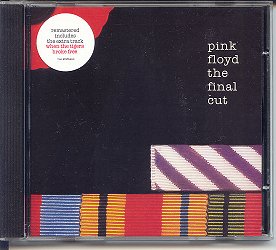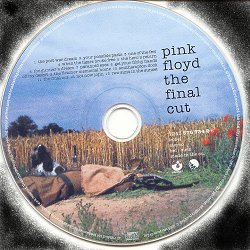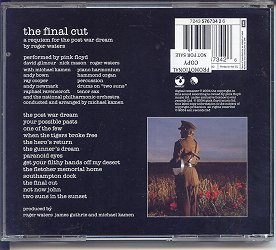 Including
the extra track "When The Tigers Broke Free" and new 16 page booklet.
Released by EMI Records, Europe, 29th March 2004 and Capitol Records,
USA, 4th May 2004 Including
the extra track "When The Tigers Broke Free" and new 16 page booklet.
Released by EMI Records, Europe, 29th March 2004 and Capitol Records,
USA, 4th May 2004
Order your copy: the 2004 remaster of The Final Cut can be ordered at a reduced price through these links: US/International, UK/Elsewhere, France, or Germany.
Some might question the remaster
and reissue of a largely overlooked and not overly cherished album from
the extensive canon of Floyd's back catalogue. It is worth remembering
though that thematically the album is important and links in with
themes explored by Roger Waters in The Wall, and subsequently expanded
upon in his solo career following his departure from the band (which
this album marked the end of that particular era).
It is also worth revisiting the
album - fresh ears reveal a great deal of good work throughout the
album. Fans of Roger's solo works will particularly latch onto various
parts, and indeed one of the tracks will be familiar to those who have
attended Roger's concerts since this album was originally released in
1983 - Southampton Dock has become a staple of his live show.
It is true that the album was not
one of the easiest or happiest that the band recorded, and signs of
"classic" Floyd music are hard to find, but the well-recorded and rich
soundscape pays dividends to those who spend the time getting to know
the album. This new version gets the James Guthrie polish, and the
addition of the track that was originally destined to join other
leftovers from The Wall, on what was called for some time "Spare
Bricks".
The positioning of this
additional track, When The Tigers Broke Free, provoked some controversy
when the plans to reissue the album with it included were first
revealed. In this review, we will look at how well it fits with the
album, and in the location finally decided upon, along with a look at
how this new version sounds. Also, we will talk about the changes to
the packaging...
THE AUDIO:
 From
the opening seconds of cars passing, a radio being tuned, and jingling
coins, it is clear that Guthrie has done a fine job. The Post War Dream
comes across with a lot more dynamics and depth, and this feel persists
throughout the album. Instrumentation sounded a little weak on the
original CD, as did some of the vocal. No such problems on this new
edition! The heavy use of atmospheric or sound effect is also enhanced
on this version of the album, but without boosting them so that the
listener's focus is altered. From
the opening seconds of cars passing, a radio being tuned, and jingling
coins, it is clear that Guthrie has done a fine job. The Post War Dream
comes across with a lot more dynamics and depth, and this feel persists
throughout the album. Instrumentation sounded a little weak on the
original CD, as did some of the vocal. No such problems on this new
edition! The heavy use of atmospheric or sound effect is also enhanced
on this version of the album, but without boosting them so that the
listener's focus is altered.
Clarity is such that a little
background hiss can be heard in places on Roger's vocal, especially on
The Post War Dream, but not to a degree that could distract. Nick's
drumming on Your Possible Pasts is a joy to hear, and the delicate
acoustic and bass guitars on One Of The Few have never sounded better.
Raph Ravenscroft soaring tenor
sax on The Gunner's Dream reaches new heights, a nice counterpoint to
the late Michael Kamen's delicate piano work on the same track. Some of
the holophonic work (yep, they've not left that out!) works even better
- listen to Paranoid Eyes and ...Desert for good examples of the effect.
To illustrate the new clarity,
Southampton Dock has a few places where you can easily hear Roger open
his mouth ready to deliver the vocal! The tenderness of the title
track, a rare love song, comes across in Roger's plaintive, delicate,
and at some points strained, vocal. The song also gives David Gilmour a
brief chance of a guitar workout, before he's pressed into heavier
service with Not Now John, never one of my favourites. To be honest, I
was expecting this song to sound a little better than it does; not to
say it is poor, and of course, towards the end it gets pretty dense
with instrumentation and dialog...but I was certainly expecting better
things here.
Finally, Two Suns In The Sunset.
A fairly sparse track in places, looking at the futility of nuclear
war, and the revised clarity found here just serves to make Andy
Newmark's drumming sound even closer to Nick's than ever before. A
great end to the album, and a sad parting of the ways for Roger, David
and Nick.
All comparisons have been done with the original UK EMI edition, in a dedicated listening suite.
THE EXTRA TRACK:
To amend the running order of any
Pink Floyd album is a guarantee to get much discussion and angst from
the Floyd fan community. Any changes therefore need to be undertaken
carefully, sensitively and with reason. When The Tigers Broke Free was
due to appear on The Final Cut when it (Tigers) came out as a gatefold
sleeved 7" single. Indeed, I recall surprise at the time when it didn't
appear.
The omission has been rectified,
with the track appearing between One Of The Few and The Hero's
Return... initial reports were that it was to be sited after Two Suns
In The Sunset, which, if true, would have been disasterous, spoiling
any atmosphere built up as the song fades.
Whilst sonically it was clearly
recorded seperate to the rest of the album, not sounding quite as good,
the Pontardulais Male Voice Choir do sound suitably stirring. The brass
and percussion sound a little flat in places though, and Roger's vocal
also suffers a little.
Positionally, it works,
absolutely without question - indeed, on relistening to the original
version, The Hero's Return seems to start too soon, and thematically
Tigers works well in context. It is a shame, though, that Tigers can be
added into the album, but the second part of The Hero's Return remains
as just the B-side to the Not Now John single. Maybe one for the 25th
Anniversary edition!
THE PACKAGING:
 As
you can see from the shots accompanying this review, a certain amount
of revision of the original packaging has been undertaken - and for the
better. None of it is out of place. As
you can see from the shots accompanying this review, a certain amount
of revision of the original packaging has been undertaken - and for the
better. None of it is out of place.
Firstly, the front cover features
much sharper reproduction of the medal ribbons, under the slightly
smaller album titling. The case features a removable sticker, promoting
the extra track, rather than being printed on the cover itself. Turning
to the rear, the picture of the soldier with the knife in his back
looks a lot better. A direct comparison almost makes one think that the
original is a cheap copy! Credits now appear for the album, on the
rear, alongside the song titles, and a Harvest logo still appears. The
original edition wins out, though, in not having the bar code to spoil
the party.
The booklet has had a timely
expansion, showcasing Roger's own designs for the album. The rear of
the booklet now features an enlarged knifed soldier, unlike the
original which had the track listing as well.
It is inside the booklet where
the real changes are noticed. Gone is the iffy printing, where the text
is indistinct in places, and the whole page explaining what Compact
Discs are all about. In comes nine extra pages, two new (circular)
pictures - one of which is reproduced on the disc itself, now in full
colour compared to the bland text-only before - and lyrics you can
read!
There's only two changes to the
credits - the removal of "artwork: artful dodgers", and the amendment
to the mastering to show James Guthrie and Joel Plante's work at
Guthrie's Das Boot recording studio. Pink Floyd's management is still
shown as (the late) Steve O'Rourke, and the overall copyright is
changed from "Pink Floyd Music Publishers" to "Roger Waters Music
Overseas" - although on the back of the CD, it credits "Pink Floyd
Music Ltd"!
Overall, then, a worthy upgrade
to your existing edition of the album. Not, as I mentioned earlier, the
obvious choice for a remaster at this stage, but a welcome one
nonetheless...and may result in many people re-appraising the music
within.
|








 Including
the extra track "When The Tigers Broke Free" and new 16 page booklet.
Released by EMI Records, Europe, 29th March 2004 and Capitol Records,
USA, 4th May 2004
Including
the extra track "When The Tigers Broke Free" and new 16 page booklet.
Released by EMI Records, Europe, 29th March 2004 and Capitol Records,
USA, 4th May 2004 From
the opening seconds of cars passing, a radio being tuned, and jingling
coins, it is clear that Guthrie has done a fine job. The Post War Dream
comes across with a lot more dynamics and depth, and this feel persists
throughout the album. Instrumentation sounded a little weak on the
original CD, as did some of the vocal. No such problems on this new
edition! The heavy use of atmospheric or sound effect is also enhanced
on this version of the album, but without boosting them so that the
listener's focus is altered.
From
the opening seconds of cars passing, a radio being tuned, and jingling
coins, it is clear that Guthrie has done a fine job. The Post War Dream
comes across with a lot more dynamics and depth, and this feel persists
throughout the album. Instrumentation sounded a little weak on the
original CD, as did some of the vocal. No such problems on this new
edition! The heavy use of atmospheric or sound effect is also enhanced
on this version of the album, but without boosting them so that the
listener's focus is altered. As
you can see from the shots accompanying this review, a certain amount
of revision of the original packaging has been undertaken - and for the
better. None of it is out of place.
As
you can see from the shots accompanying this review, a certain amount
of revision of the original packaging has been undertaken - and for the
better. None of it is out of place.



